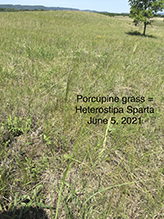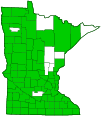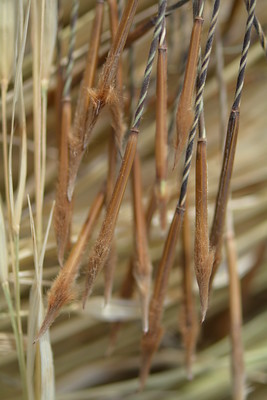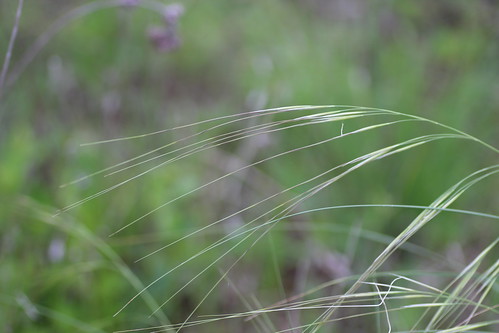porcupine grass
(Hesperostipa spartea)
Conservation • Description • Habitat • Ecology • Use • Distribution • Taxonomy
Conservation Status |
|
|||||||
| IUCN Red List | not listed |
|||||||
| NatureServe | N5? - Secure SNR - Unranked |
|||||||
| Minnesota | not listed |
|||||||
Description |
||
Porcupine grass is a tall, cool season (C3) bunchgrass. It occurs in North America from Ontario to British Columbia south to Alabama and New Mexico. It is most common in the central and Great Lakes regions. It is very common in Minnesota. It is found as bunches of individual plants in dry to moderately dry prairies, on roadsides, and in railroad rights-of-way. It grows most actively in the spring and early summer, usually under full sun in sandy or gravelly soil, but also in loamy soil and in light shade. Porcupine grass has deep fibrous roots. Bunches are 2½′ to 3½′ tall and can have a foliage spread of 3′ to 6′ in diameter. The stems (culms) are round, hollow, and pale green. They can be 18″ to 57″ (45 to 145 cm) long but are usually no more than 36″ (90 cm) long. They are erect at first but soon lean over due to the weight of the developing spikelets. They do not branch at the upper nodes. They are mostly hairless but often have lines of minute hairs at the nodes. These may not be visible without strong (20x) magnification. Both basal leaves and a few stem leaves are produced. Stem leaves are few and alternate. The leaf blade is linear to lance-shaped. It can be 6″ to 26″ (15 to 65 cm) long and 1⁄16″ to ¼″ (2 to 6 mm) wide, but is usually no more than 18″ (45 cm) long. It is narrowed but not twisted at the base, and tapers to a long fine point at the tip. The veins are parallel, the midvein is not thickened, and there are no evident cross-veins. The upper surface is rough, hairy, and conspicuously ridged. The underside is hairless and sometimes roughened. The margins are flat but often curl tightly inward in response to dry conditions. The lower part of the leaf surrounding the stem (sheath) is open for all or most of its length. There is usually a fringe of hairs on the lower margin though this may be hard to see. It is otherwise hairless. There are no ear-like extensions (auricles) at the top of the sheath. The area on the outer side where the blade meets the sheath (collar) does not have tufts of hairs on the sides. The appendage on the inner side at the junction of the blade and the sheath (ligule) is white and membranous.The ligule on lower leaves is 1⁄32″to ⅛″ (0.3 to 3.0 mm) long, stiff, and straight across to rounded. It usually does not appear torn (lacerate). The ligule on upper leaves is ⅛″ to ¼″ (3.0 to 7.5 mm) long, thin, pointed, and often lacerate. Basal leaves are similar to stem leaves but are a little longer. Stems and stem leaves turn brown in the fall, but basal leaves remain green as other grasses turn brown. The inflorescence is a 4″ to 10″ (10 to 25 cm) long, narrow, few-branched arrangement (panicle) of spikelets at the end of the stem. Sometimes 2 or 3 additional panicles develop at the uppermost stem nodes. Each branch of the panicle is erect and slender, and bears 1 or 2 spikelets. The panicle leans to one side due to the weight of the developing spikelets. Each spikelet has one modified flower (floret) with 2 bracts (glumes) at the base. Each glume is ⅞″ to 1¾″ (2 to 45 mm) long, is linear lance-shaped, tapers to a long-pointed or hair-like tip, and has 5 or 7 nerves. The outer surface is hairless. The glumes are longer than on other needle grasses in Minnesota. They remain on the plant long after seed dispersal, which is helpful in identifying this plant in late summer and fall. The floret consists of an outer bract (lemma), an inner bract (palea), and a flower with both male and female parts (perfect). The body of the lemma is brown, not shiny, hard, linear, tapered at the tip to a very long awn, and ⅝″ to 1″ (15 to 25 mm) long not including the awn. The outer surface is densely hairy on the margins and in lines on the lower part, hairless on the upper part. The hairs are brown at maturity. The awn is 3½″ to 7½″ (90 to 190 mm) long. It is bent at a sharp angle twice near the middle but it is not jointed. The central segment is usually ⅝″ to 1 3⁄16″ (15 to 30 mm) long. The lower two segments are spirally coiled when dry, the terminal segment is straight, not twisted. Following seed dispersal the awns coil and uncoil as moisture conditions change, screwing the fruit into the ground. The hairs near the tip face backward and prevent the fruit from backing out of the soil. The palea is flat, pinched or prow-like at the tip, and equal in length to the lemma. It is leathery, hairy, and has two veins. The veins terminate at the tip of the palea. |
||
Height |
||
18″ to 57″ (45 to 145 cm) |
||
Similar Species |
||
Habitat |
||
Dry to moderate moisture. Prairies, roadsides, and railroads. Full sun. |
||
Ecology |
||
Flowering |
||
May to July |
||
Pests and Diseases |
||
|
||
Toxicity |
||
The sharp awns can cause injury to the eyes, nose, mouth, and intestines of livestock |
||
Use |
||
|
||
Distribution |
||||
|
Sources |
|||
| 1/1/2022 | ||||
Nativity |
||||
Native |
||||
Occurrence |
||||
Very common in Minnesota |
||||
Taxonomy |
|||
| Kingdom | Plantae (Plants) | ||
| Division | Tracheophyta (Vascular Plants) | ||
| Subdivision | Spermatophytina (Seed Plants) | ||
| Class | Liliopsida (Monocots) | ||
Order |
Poales (grasses, sedges, cattails, and allies) | ||
Family |
Poaceae (grasses) | ||
| No Rank | BOP clade | ||
| Subfamily | Pooideae | ||
| Supertribe | Stipodae | ||
Tribe |
Stipeae (needlegrasses and allies) | ||
Genus |
Hesperostipa (porcupine grasses) | ||
This species was formerly in the genus Stipa. In 1993 all North American species were excluded from that genus. Four species were transferred to the new genus Hesperostipa based on the hard tip of the palea and the pattern of the veins on its surface. Hespero is from Classical Greek and means “western”. |
|||
Subordinate Taxa |
|||
|
|||
Synonyms |
|||
Stipa robusta Stipa spartea Stipa spartea var. spartea |
|||
Common Names |
|||
big needlegrass porcupine grass porcupinegrass porcupine needlegrass short-awn porcupine grass western porcupine grass |
|||
Glossary
Bract
Modified leaf at the base of a flower stalk, flower cluster, or inflorescence.
Collar
In grasses: The area on the back of a grass leaf at the junction of the sheath and the blade. On moths: the upperside of the prothorax.
Culm
The hollow or pithy stem of a grass, sedge, or rush.
Floret
An individual flower in a dense cluster of flowers; or a modified flower in the flower head in the Asteraceae family and some other families. In grasses, the modified flower in a spikelet of Poaceae and some Cyperaceae with its lemma and palea.
Glume
A chaffy, empty, sterile bract at the base of a grass spikelet. Glumes usually occur in pairs, but occasionally only one is present.
Lemma
The outer, lowermost of the pair of bracts at the base of the grass floret; it ensheathes the palea.
Ligule
In grasses and sedges, an outgrowth on the leaf at the junction of the blade and the sheath, usually membranous, sometimes no more than a fringe of hairs. In flowering plants, the ligule is the flat, strap-shaped, petal-like portion of the corolla of a ray floret.
Linear
Long, straight, and narrow, with more or less parallel sides, like a blade of grass.
Palea
The inner, uppermost of the pair of bracts at the base of the grass floret.
Panicle
A pyramidal inflorescence with a main stem and branches. Flowers on the lower, longer branches mature earlier than those on the shorter, upper ones.
Sheath
The lower part of the leaf that surrounds the stem.
Spikelet
In flowering plants, a small spike. In grasses and sedges, the basic unit of inflorescence. In grasses, composed of usually two glumes and one or more florets. In sedges, a single flower and its single associated scale.
Visitor Photos |
|||||
Share your photo of this plant. |
|||||
| This button not working for you? Simply email us at info@MinnesotaSeasons.com. Attach one or more photos and, if you like, a caption. |
|||||
Nancy Falkum |
|||||
Landscape Looking West Minnesota River bluffs in background |
|||||
 |
|||||
MinnesotaSeasons.com Photos |
|||||
|
|||||


Visitor Videos |
|||
Share your video of this plant. |
|||
| This button not working for you? Simply email us at info@MinnesotaSeasons.com. Attach a video, a YouTube link, or a cloud storage link. |
|||
Other Videos |
|||
| Hesperostipa spartea (Porcupine grass) Botany and Beer |
|||
About
Jul 28, 2021 One of the most charismatic and unforgettable prairie/savanna grasses of the Midwest. |
|||
| Hesperostipa spartea awns Josh Drizin |
|||
About
Jul 22, 2010 Hesperostipa awns spartea curling like crazy when the humidity drops. Time-lapsed at 5 seconds between each frame |
|||

Visitor Sightings |
|||||
Report a sighting of this plant. |
|||||
| This button not working for you? Simply email us at info@MinnesotaSeasons.com. Be sure to include a location. |
|||||
| Nancy Falkum 6/5/2021 |
Location: Kellogg Weaver Dunes SNA, Weaver Dunes Unit Landscape Looking West Minnesota River bluffs in background |
||||
MinnesotaSeasons.com Sightings |
|||||

Created: 1/1/2022
Last Updated:



